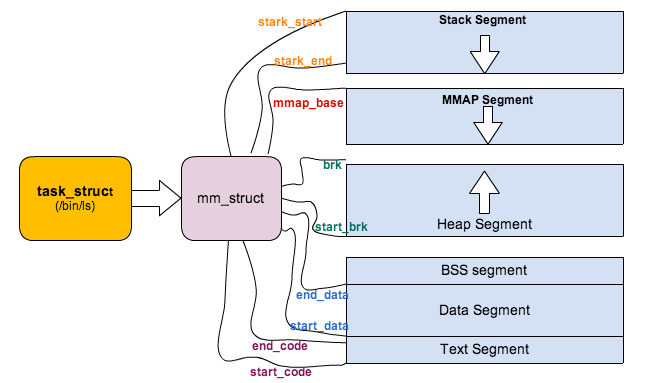http://blog.csdn.net/dyllove98/article/details/8917197
Linux对于内存的管理涉及到非常多的方面,这篇文章首先从对进程虚拟地址空间的管理说起。(所依据的代码是2.6.32.60)

215 atomic_t mm_users; /* How many users with user space? */ 216 atomic_t mm_count; /* How many references to "struct mm_struct" (users count as 1) */
这两个counter乍看好像差不多,那Linux使用中有什么区别呢?看代码就是最好的解释了。
681static int copy_mm(unsigned long clone_flags, struct task_struct * tsk)
682{
683 struct mm_struct * mm, *oldmm;
684 int retval;
692 tsk->mm = NULL;
693 tsk->active_mm = NULL;
694
695 /*
696 * Are we cloning a kernel thread?
697 *
698 * We need to steal a active VM for that..
699 */
700 oldmm = current->mm;
701 if (!oldmm)
702 return 0;
703
704 if (clone_flags & CLONE_VM) {
705 atomic_inc(&oldmm->mm_users);
706 mm = oldmm;
707 goto good_mm;
708 }
无论我们在调用fork,vfork,clone的时候最终会调用do_fork函数,区别在于vfork和clone会给copy_mm传入一个CLONE_VM的flag,这个标识表示父子进程都运行在同样一个‘虚拟地址空间’上面(在Linux称之为lightweight process或者线程),当然也就共享同样的物理地址空间(Page Frames)。
copy_mm函数中,如果创建线程中有CLONE_VM标识,则表示父子进程共享地址空间和同一个内存描述符,并且只需要将mm_users值+1,也就是说mm_users表示正在引用该地址空间的thread数目,是一个thread level的counter。
mm_count呢?mm_count的理解有点复杂。
对Linux来说,用户进程和内核线程(kernel thread)都是task_struct的实例,唯一的区别是kernel thread是没有进程地址空间的,内核线程也没有mm描述符的,所以内核线程的tsk->mm域是空(NULL)。内核scheduler在进程context switching的时候,会根据tsk->mm判断即将调度的进程是用户进程还是内核线程。但是虽然thread thread不用访问用户进程地址空间,但是仍然需要page table来访问kernel自己的空间。但是幸运的是,对于任何用户进程来说,他们的内核空间都是100%相同的,所以内核可以’borrow'上一个被调用的用户进程的mm中的页表来访问内核地址,这个mm就记录在active_mm。
简而言之就是,对于kernel thread,tsk->mm == NULL表示自己内核线程的身份,而tsk->active_mm是借用上一个用户进程的mm,用mm的page table来访问内核空间。对于用户进程,tsk->mm == tsk->active_mm。
为了支持这个特别,mm_struct里面引入了另外一个counter,mm_count。刚才说过mm_users表示这个进程地址空间被多少线程共享或者引用,而mm_count则表示这个地址空间被内核线程引用的次数+1。
比如一个进程A有3个线程,那么这个A的mm_struct的mm_users值为3,但是mm_count为1,所以mm_count是process level的counter。维护2个counter有何用处呢?考虑这样的scenario,内核调度完A以后,切换到内核内核线程B,B ’borrow' A的mm描述符以访问内核空间,这时mm_count变成了2,同时另外一个cpu core调度了A并且进程A exit,这个时候mm_users变为了0,mm_count变为了1,但是内核不会因为mm_users==0而销毁这个mm_struct,内核只会当mm_count==0的时候才会释放mm_struct,因为这个时候既没有用户进程使用这个地址空间,也没有内核线程引用这个地址空间。
We'll try to explain the difference between the use of mm_users and mm_count with an example. Consider a memory descriptor shared by two lightweight processes. Normally, its mm_users field stores the value 2, while its mm_count field stores the value 1 (both owner processes count as one).
If the memory descriptor is temporarily lent to a kernel thread (see the next section), the kernel increases the mm_count field. In this way, even if both lightweight processes die and the mm_users field becomes zero, the memory descriptor is not released until the kernel thread finishes using it because the mm_count field remains greater than zero.